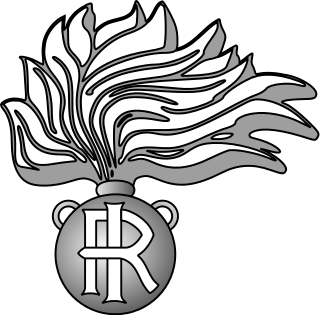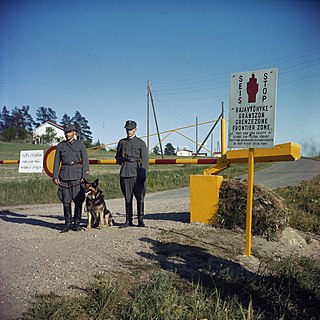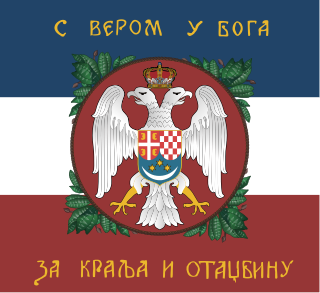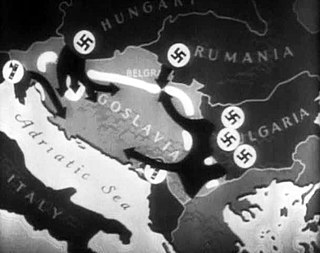
The Italian Armed Forces encompass the Italian Army, the Italian Navy and the Italian Air Force. A fourth branch of the armed forces, known as the Carabinieri, take on the role as the nation's military police and are also involved in missions and operations abroad as a combat force. Despite not being a branch of the armed forces, the Guardia di Finanza is organized along military lines. These five forces comprise a total of 340,885 men and women with the official status of active military personnel, of which 167,057 are in the Army, Navy and Air Force. The President of the Italian Republic heads the armed forces as the President of the High Council of Defence established by article 87 of the Constitution of Italy. According to article 78, the Parliament has the authority to declare a state of war and vest the powers to lead the war in the Government.

The Carabinieri are the national gendarmerie of Italy who primarily carry out domestic and foreign policing duties. It is one of Italy's main law enforcement agencies, alongside the Polizia di Stato and the Guardia di Finanza. As with the Guardia di Finanza but in contrast to the Polizia di Stato, the Carabinieri are a military force. As the fourth branch of the Italian Armed Forces, they come under the authority of the Ministry of Defence; for activities related to inland public order and security, they functionally depend on the Ministry of the Interior. In practice, there is a significant overlap between the jurisdiction of the Polizia di Stato and Carabinieri, although both of them are contactable through 112, the European Union's Single Emergency number. Unlike the Polizia di Stato, the Carabinieri have responsibility for policing the military, and a number of members regularly participate in military missions abroad.

A gendarmerie is a military force with law enforcement duties among the civilian population. The term gendarme is derived from the medieval French expression gens d'armes, which translates to "men-at-arms". In France and some Francophone nations, the gendarmerie is a branch of the armed forces that is responsible for internal security in parts of the territory, with additional duties as military police for the armed forces. It was introduced to several other Western European countries during the Napoleonic conquests. In the mid-twentieth century, a number of former French mandates and colonial possessions adopted a gendarmerie after independence.

The Polizia di Stato is one of the national police forces of Italy. Alongside the Carabinieri, it is the main police force for providing police duties, primarily to cities and large towns, and with its child agencies it is also responsible for highway patrol, railways, airports, customs, as well as certain waterways, and assisting the local police forces.

Law enforcement in Italy is centralized on a national level, carried out by multiple national forces, helped by few limited local agencies. The Italian law enforcement system is considered complex, with multiple police forces and other agencies taking part in different duties. Policing in the Italian system refers to the duties of "full-powered officers" coming from the four national main forces: Polizia di Stato, Carabinieri, Polizia Penitenziaria and Guardia di Finanza. While the duties of these four corps' include investigating and arresting, other local forces carry out limited duties.

A border guard of a country is a national security agency that ensures border security. Some of the national border guard agencies also perform coast guard and rescue service duties.
Gruppo d'investigazione sulla criminalità organizzata also knew with the acronym GICO, is a specialized department of the Italian Guardia di Finanza, a Special Police force that combats international drugs trafficking, smuggling, money laundering, terrorist financing, financial crimes and illegal immigration. It also performs customs control and border protection missions, anti-Mafia operations, maintains public order and safety, and contributes to the political and military defense of Italy.

The Counter-terrorism Rapid Response, formed in 1983, is a special police unit of Italy's Guardia di Finanza. It is tasked with counter-terrorism operations and the protection of VIPs and places of interest in the country. The ATPI has also participated in operations in Albania, Kosovo, and Hungary.

The Yugoslav Army, commonly the Royal Yugoslav Army, was the principal ground force of the Kingdom of Yugoslavia. It existed from the establishment of Yugoslavia in December 1918 until its surrender to the Axis powers on 17 April 1941. Aside from fighting along the Austrian border in 1919 and 1920 related to territorial disputes, and some border skirmishes on its southern borders in the 1920s, the JV was not involved in fighting until April 1941 when it was quickly overcome by the German-led invasion of Yugoslavia.

The 7th Infantry Division "Lupi di Toscana" was an infantry division of the Royal Italian Army during World War II. The Division, with the exception of the 78th Infantry Regiment based in Bergamo, was based in Brescia. Despite its name referencing the region of Tuscany, the division was formed by men from Lombardy, especially from Brescia, Bergamo and the surrounding valleys.

The 23rd Infantry Division "Ferrara" was a infantry division of the Royal Italian Army during World War II. The Ferrara was classified as a mountain infantry division, which meant that the division's artillery was moved by pack mules instead of the horse-drawn carriages of line infantry divisions. Italy's real mountain warfare divisions were the six alpine divisions manned by Alpini mountain troops. The division was named for the city of Ferrara and based in Bari. The division's men were mostly recruited from Bari and in the Altopiano delle Murge region.

The 59th Infantry Division "Cagliari" was a infantry division of the Royal Italian Army during World War II. The Cagliari was classified as a mountain infantry division, which meant that the division's artillery was moved by pack mules instead of the horse-drawn carriages of line infantry divisions. Italy's real mountain warfare divisions were the six alpine divisions manned by Alpini mountain troops.

The 53rd Infantry Division "Arezzo" was a infantry division of the Royal Italian Army during World War II. The Arezzo was classified as a mountain infantry division, which meant that the division's artillery was moved by pack mules instead of the horse-drawn carriages of line infantry divisions. Italy's real mountain warfare divisions were the six alpine divisions manned by Alpini mountain troops.
Civil Guard of Costa Rica was a gendarmerie type force responsible for both limited national defense and internal security missions.

The Karaburun tragedy of 2004, also known as the 9 January tragedy, was a marine incident that occurred during an attempted sea crossing from northern Albania to Italy by 36 people, including two dinghy operators and the smugglers' leader. They were trying to cross the Strait of Otranto, off the southern coast of Italy, in an inflatable boat, heading towards Brindisi, on the Adriatic coast of Apulia. Twenty-eight people died or were declared lost at sea, and there were only eight survivors. For Albanian emigrants, the tragedy had the second highest mortality rate for such events, after the Otranto tragedy of March 1997, when the Albanian ship Kateri i Radës, smuggling clandestine emigrants, was hit by the Italian warship Sibilla, resulting in the death of 84 people.
The Royal Albanian Air Corps existed from 1928 until 1939 and was a branch of the Royal Albanian Army. Of those European states that possessed an air corps in the years between the world wars, that of Albania was by far the smallest, numbering at most just five aircraft.

The Axis order of battle for the invasion of Yugoslavia was made up of the various operational formations of the German Wehrmacht and Waffen-SS, Italian Armed Forces and Hungarian Armed Forces that participated in the invasion of Yugoslavia during World War II, commencing on 6 April 1941. It involved the German 2nd Army, with elements of the 12th Army and a panzer group combined with overwhelming Luftwaffe support. The eighteen German divisions included five panzer divisions, two motorised infantry divisions and two mountain divisions. The German force also included two well-equipped independent motorised regiments and was supported by over 800 aircraft. The Italian 2nd Army and 9th Army committed a total of 22 divisions, and the Royal Italian Air Force had over 650 aircraft available to support the invasion. The Hungarian 3rd Army also participated, with support from the Royal Hungarian Air Force.

The Guardia di Finanza is an Italian law enforcement agency under the authority of the minister of economy and finance. It is a militarized police force, forming a part of the Ministry of Economy and Finance, not the Ministry of Defence. Guardia di Finanza is essentially responsible for dealing with financial crime and smuggling; it has also evolved into Italy's primary agency for suppressing the illegal drug trade. It maintains over 600 boats and ships and more than 100 aircraft to serve in its mission of patrolling Italy's territorial waters. It also has the role of border police and customs duties at Italian airports.














